Level Titles: Beyond D&D
Having now covered all of the published TSR era D&D and AD&D character classes with level titles, I wanted to turn to some other RPGs published by the same company that also include them. First up is Empire of the Petal Throne (1975), which only makes sense, as the game's rules were essentially a variant of OD&D. Here is the chart featuring level titles for all three character classes available in that game:
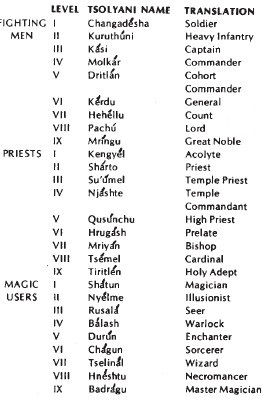 There are a couple of notable ways that this chart differs from its D&D predecessors. The first and most obvious is that these titles aren't in English. Instead, they're in the Tsolyáni constructed language used in the setting, though they are accompanied by rough English translations. Secondly and more importantly, most of these titles have a meaning within the setting. For example, the titles of the fighting man class are, from levels 1 through 6, actual titles within the Tsolyáni legions. Likewise, the titles of both the priest and magic-user classes are those of ranks within the "circles" (an administrative term) of the temple priesthoods and lay priesthoods respectively. In short, these level titles aren't arbitrary names but rather markers of attainment within Tsolyánu.
There are a couple of notable ways that this chart differs from its D&D predecessors. The first and most obvious is that these titles aren't in English. Instead, they're in the Tsolyáni constructed language used in the setting, though they are accompanied by rough English translations. Secondly and more importantly, most of these titles have a meaning within the setting. For example, the titles of the fighting man class are, from levels 1 through 6, actual titles within the Tsolyáni legions. Likewise, the titles of both the priest and magic-user classes are those of ranks within the "circles" (an administrative term) of the temple priesthoods and lay priesthoods respectively. In short, these level titles aren't arbitrary names but rather markers of attainment within Tsolyánu. Empire of the Petal Throne is not, however, the only TSR RPG to include level titles. Another one that does so is Top Secret (1980) and its titles seem to have a lot in common with those of Dungeons & Dragons. Take, for example, the titles of the Investigation section:
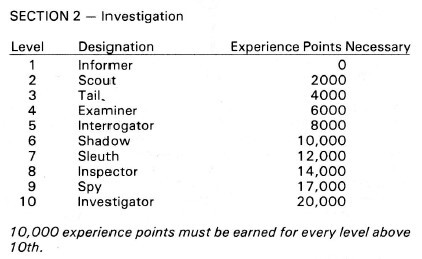 Like most of their D&D predecessors, the Top Secret level titles (or "designations") are just synonyms related to the class in question, as you can see in the case of the Confiscation section:
Like most of their D&D predecessors, the Top Secret level titles (or "designations") are just synonyms related to the class in question, as you can see in the case of the Confiscation section:
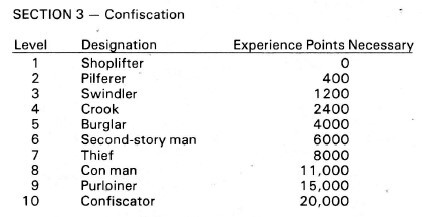 If anything, the Confiscation titles are even less plausible than those for Investigation. Shoplifter? Crook? Those don't strike me as at all credible internal designations for a covert operative. Consider, too, the Assassination section:
If anything, the Confiscation titles are even less plausible than those for Investigation. Shoplifter? Crook? Those don't strike me as at all credible internal designations for a covert operative. Consider, too, the Assassination section:
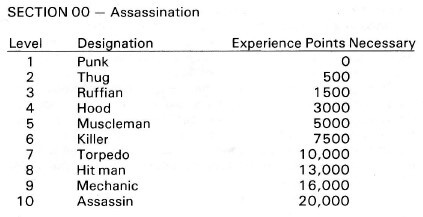 Punk? Hood? Muscleman? As I said, these strike me as simply synonyms – and of a decidedly colloquial sort – rather than anything that could be accepted as having any purpose within the world of the game itself.
Punk? Hood? Muscleman? As I said, these strike me as simply synonyms – and of a decidedly colloquial sort – rather than anything that could be accepted as having any purpose within the world of the game itself. On the other hand, there's Gangbusters (1982), which includes level titles for some of its character professions, but not others. For example, these are the titles for FBI agents:
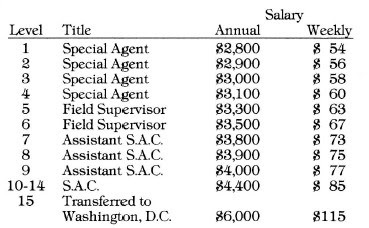 You'll notice several things about this chart. Firstly, not every level has a unique title. Secondly, each increase in level includes a commensurate increase in salary, which has a real in-game effect. The titles in Gangbusters are, in this way, go beyond even those of Empire of the Petal Throne in being something that definitely exists within the game world rather than being simply an artifact of the game rules. For the sake of completeness here are the charts for Prohibition Agents and police officers:
You'll notice several things about this chart. Firstly, not every level has a unique title. Secondly, each increase in level includes a commensurate increase in salary, which has a real in-game effect. The titles in Gangbusters are, in this way, go beyond even those of Empire of the Petal Throne in being something that definitely exists within the game world rather than being simply an artifact of the game rules. For the sake of completeness here are the charts for Prohibition Agents and police officers:
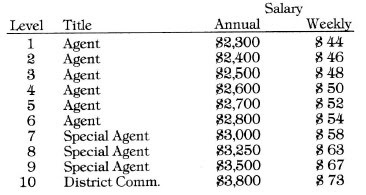
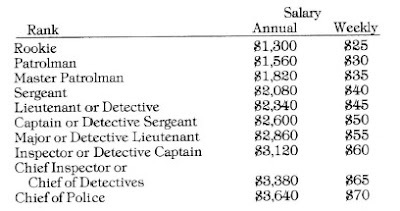 Clearly, Gangbusters puts level titles to the best use of all the roleplaying games so far examined, in that they not only reflect a setting-based reality (i.e. promotion within a character's profession) but also provides a setting-based benefit in the form of increased pay. These are small things, to be sure, and one could reasonably argue that there's no need to present such things in this fashion. However, given that Gangbusters uses a level-based system, albeit one very different from D&D, it makes some sense to do it this way. In any event, I think it's fair to say Gangbusters does level titles better than D&D and Top Secret.
Clearly, Gangbusters puts level titles to the best use of all the roleplaying games so far examined, in that they not only reflect a setting-based reality (i.e. promotion within a character's profession) but also provides a setting-based benefit in the form of increased pay. These are small things, to be sure, and one could reasonably argue that there's no need to present such things in this fashion. However, given that Gangbusters uses a level-based system, albeit one very different from D&D, it makes some sense to do it this way. In any event, I think it's fair to say Gangbusters does level titles better than D&D and Top Secret.
Published on August 29, 2024 21:00
No comments have been added yet.
James Maliszewski's Blog
- James Maliszewski's profile
- 3 followers
James Maliszewski isn't a Goodreads Author
(yet),
but they
do have a blog,
so here are some recent posts imported from
their feed.



